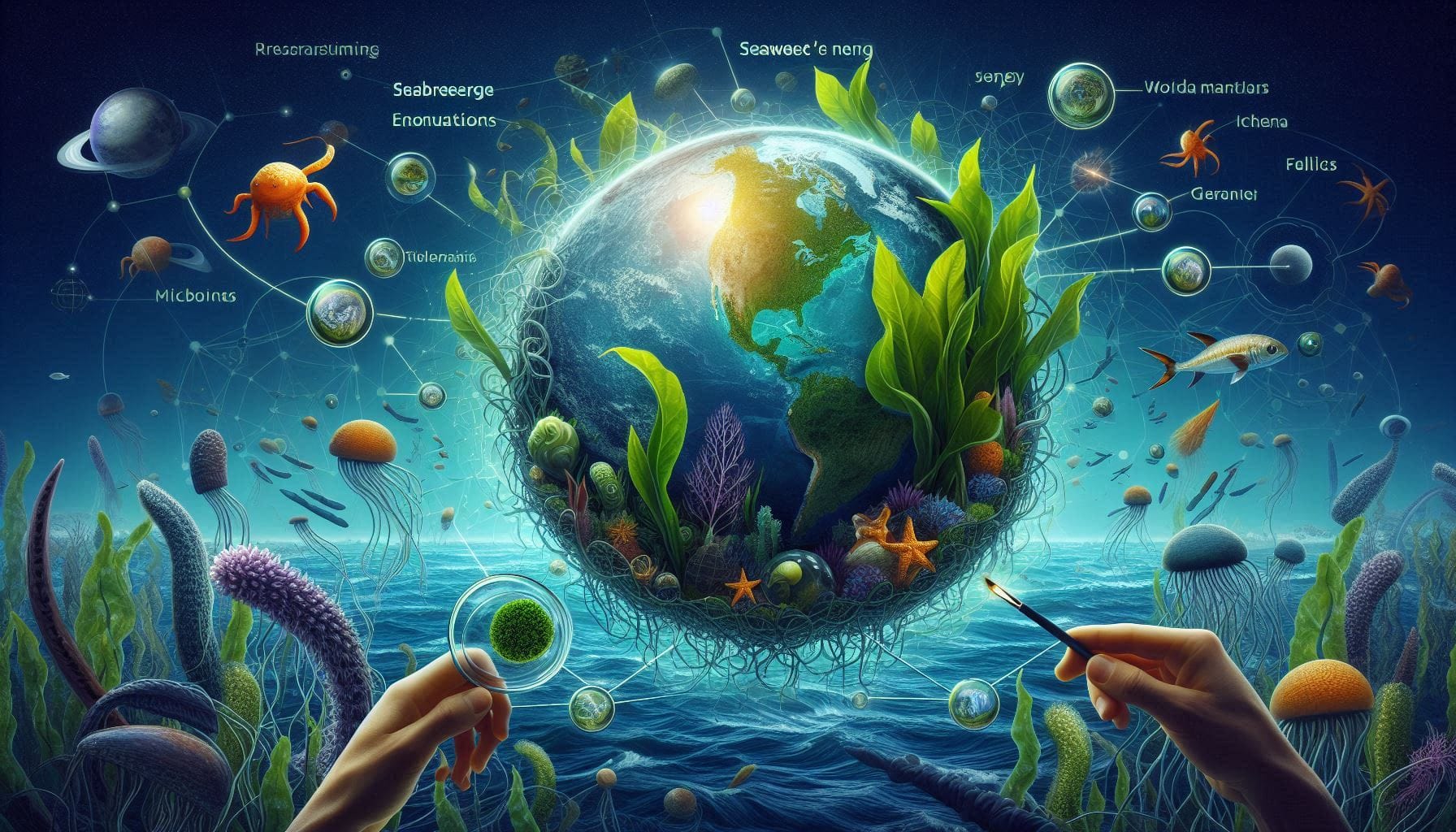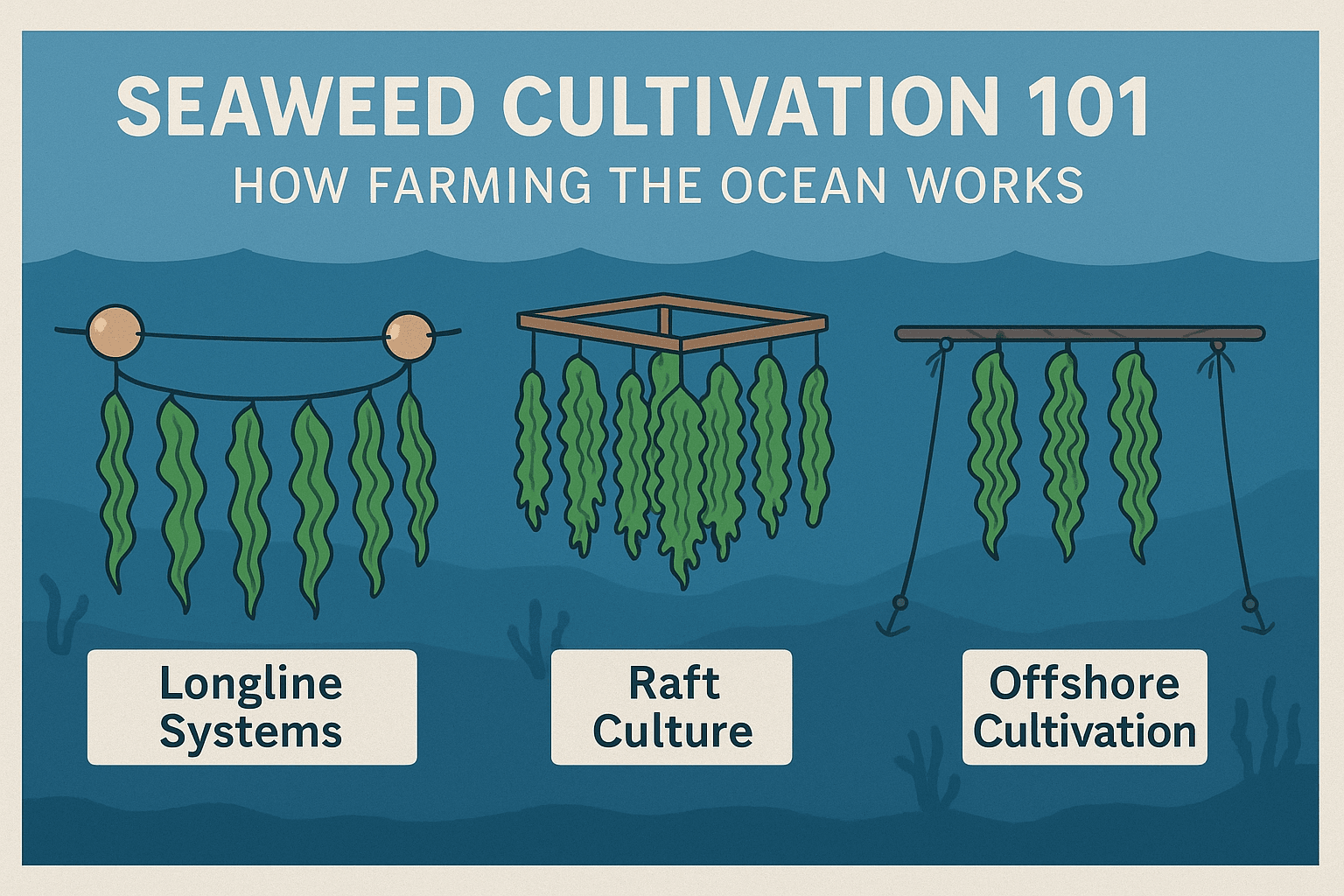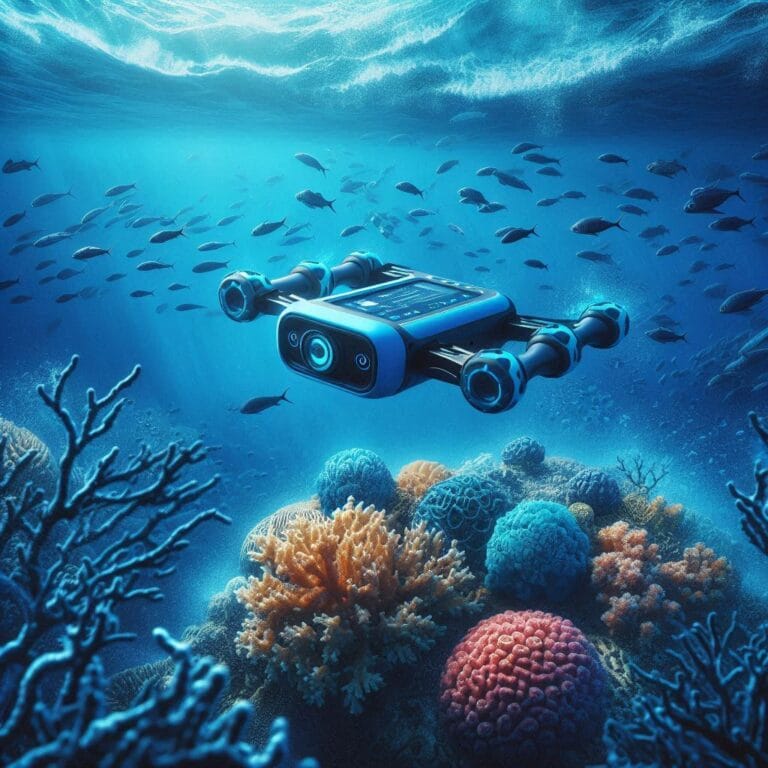🌿 Introduction: Why Seaweed is the Ocean’s Secret Weapon
Move over solar panels and lab-grown meat—seaweed is quietly emerging as one of the most versatile tools in the fight against climate change. Fast-growing, nutrient-rich, and astonishingly carbon-efficient, this humble ocean plant is now at the center of an exploding wave of seaweed tech innovations.
Unlike terrestrial crops, seaweed doesn’t require land, freshwater, or synthetic fertilizers. It grows rapidly in saltwater, absorbs up to 5x more CO₂ per hectare than terrestrial forests, and replenishes marine ecosystems as it grows. That’s why researchers and startups are eyeing seaweed cultivation not just as a food source, but as a climate solution.

From edible proteins and animal feed alternatives to biodegradable plastics and biofuels, seaweed is becoming the biomass backbone for a sustainable circular economy. And its applications don’t stop there: it can boost food security, improve coastal resilience, and drive regenerative aquaculture.
We’re entering an era where kelp farms could power your car, package your sandwich, or even store carbon dioxide from the atmosphere. Welcome to the future of marine-based innovation—where seaweed tech might be the ocean’s most underestimated superpower.
🌊 Seaweed Cultivation 101: How Farming the Ocean Works
While it may sound futuristic, seaweed farming is already a well-established practice across Asia—and it’s now catching serious momentum in Europe and North America. But how does farming the ocean actually work?
🪢 Key Farming Methods
- Longline Systems: The most common technique, where ropes seeded with seaweed spores are suspended between buoys. As the seaweed grows, it hangs downward like underwater curtains, feeding on sunlight and ocean nutrients.
- Raft Culture: Used in shallow waters, raft-style platforms float on the surface and support vertical lines or nets for growing seaweed in dense, accessible formations.
- Offshore Cultivation: A newer method designed for rougher, open-ocean environments. Here, farms are anchored deeper and engineered to withstand waves, increasing scalability while minimizing coastal space usage.

🌏 Regional Differences in Seaweed Cultivation
- Asia (esp. China, South Korea, and Japan): Home to 95% of global production, with a strong focus on food-grade species like nori, wakame, and kombu. Farming is highly optimized, with deep supply chain integration.
- Europe (e.g., Norway, Netherlands): Focuses more on biomaterials, nutraceuticals, and sustainable packaging. Cold-water species like Saccharina latissima are preferred.
- United States & Canada: Emerging market led by startups like Ocean Rainforest, GreenWave, and Cascadia Seaweed—promoting regenerative ocean farming that combines seaweed and shellfish for ecosystem benefits.
⚠️ Challenges of Sustainable Seaweed Farming
- Salinity & Temperature Variability: These factors affect yield and species viability, especially in offshore environments.
- Biofouling: The buildup of unwanted organisms (e.g., barnacles, algae) on seaweed lines can reduce quality and growth rates.
- Optimization & Scale: Breeding high-yield strains and automating harvesting processes remain active research areas in sustainable seaweed farming.
While the basic techniques are centuries old, today’s seaweed farms are evolving into data-driven, tech-augmented ecosystems—with drones, AI, and sensors guiding decisions from spore to harvest.
🧠 Seaweed Technology: How Innovation Is Scaling the Blue Economy
What once began as a low-tech, manual practice has now become a frontier for ocean innovation. Modern seaweed innovations are enhancing sustainable aquaculture through the integration of automation, AI systems, and advanced data analytics at sea.
🤖 Smart Aquaculture in Action
Seaweed farming technology has gone digital. Farms are now equipped with AI-powered monitoring systems that analyze water quality, growth rates, and biofouling risks in real time. Using satellite imaging and underwater drones, farmers can scan vast ocean plots without ever diving below the surface.
In places like Norway and Alaska, autonomous vehicles are mapping kelp forests, tracking seaweed density, and scanning for invasive species. This approach—known as smart aquaculture—allows for precision farming and early problem detection.
🌊 Automating the Seeding & Harvesting Process
Traditionally, seeding ropes with spores and manually harvesting mature seaweed was time-consuming and labor-intensive. Now, robotic arms and automated conveyor systems can seed longlines, harvest blades, and even sort biomass by species or size—dramatically improving scalability and reducing labor costs.
Pioneers like Sea6 Energy in India and Ocean Rainforest in the Faroe Islands are at the forefront, developing modular, semi-autonomous platforms that float in open seas.
🌐 Real-Time Ocean Analytics with IoT
IoT sensors deployed across seaweed farms measure salinity, nutrient levels, pH, and temperature fluctuations with minute-by-minute accuracy. These analytics are fed into dashboards that help farm operators optimize harvest timing and nutrient uptake.
In short, today’s seaweed farming technology is closer to vertical farming than traditional fishing—blending biology, data science, and robotics to unlock a cleaner, smarter blue economy.
🔋 Seaweed for Energy: The Rise of Algae-Based Biofuels
Seaweed isn’t just a climate-friendly food or packaging material—it’s also an emerging star in the world of renewable energy. As fossil fuel costs rise and emissions targets tighten, interest in seaweed-based biofuels is surging.
🔬 From Ocean Biomass to Liquid Fuel
Unlike terrestrial biofuels, seaweed grows without soil, pesticides, or freshwater—and doesn’t compete with food crops. When processed, it can yield:
- Bioethanol, via fermentation of seaweed carbohydrates
- Biogas, through anaerobic digestion of organic matter
- Jet fuel, from lipid-rich algae species or converted carbohydrates
This makes algae bioenergy one of the most promising sources for next-gen fuels, especially for aviation and shipping, where electrification is limited.
🔑 Key Innovators
- Seafields (UK): Developing sargassum-based carbon sinks in the South Atlantic that double as fuel feedstock
- MacroFuels (Netherlands): Producing seaweed-derived ethanol from cultivated brown algae
- U.S. Department of Energy (DOE): Investing in projects like MARINER, which aims to create a $10B U.S. seaweed industry by 2035, focused on bioenergy and bioproducts
These ventures are not just pilot programs—they are scaling up with real-world impact and policy support.
🌍 Economic and Environmental Viability
Seaweed’s rapid growth rate and high carbohydrate yield per acre make it a compelling alternative to corn- or sugarcane-based biofuels. Additionally, seaweed cultivation absorbs carbon dioxide, prevents ocean acidification, and restores marine biodiversity—delivering carbon-negative fuel production in some models.
While energy density and cost parity remain challenges, the long-term outlook for algae bioenergy is strong, especially as climate policies push for low-carbon fuel mandates in aviation, logistics, and defense.
🌎 Seaweed as a Climate Tech Tool
As the race to reverse climate change intensifies, seaweed is gaining attention not just as a crop, but as a powerful nature-based climate solution. Thanks to its rapid growth and nutrient uptake, seaweed plays a critical role in ocean-based carbon capture—offering a scalable way to draw CO₂ from the atmosphere and store it safely in the sea.
🌿 How Seaweed Sequesters Carbon
Seaweed absorbs CO₂ during photosynthesis, just like land plants—but much more efficiently. Some species can grow up to half a meter per day, pulling more carbon per hectare than even tropical rainforests. When harvested and turned into products (biofuels, bioplastics), or sunk into deep-sea zones, that carbon is effectively locked away—either for years or even centuries.
This makes seaweed one of the few “carbon-negative” biomass solutions available at scale.
🌊 Marine Permaculture & Ocean Afforestation
Innovators like the Climate Foundation are creating floating kelp forests in open water—known as marine permaculture arrays—that can regenerate dying ecosystems while capturing carbon. In a similar vein, ocean afforestation projects are exploring the idea of growing massive offshore seaweed farms specifically to absorb CO₂ and reduce ocean acidification.
These methods offer climate co-benefits: restoring marine biodiversity, increasing fish stocks, and boosting local economies.
🧪 Geoengineering: Caution Meets Optimism
While seaweed’s potential is undeniable, questions remain about large-scale use. Critics warn that sinking massive volumes of biomass could disrupt marine ecosystems or oxygen levels in deep waters. As with all geoengineering strategies, the key lies in transparency, regulation, and balance.
Still, when compared to land-based carbon farming, seaweed offers a low-input, high-yield solution—and with smart policy and tech, it could become a core part of global carbon removal frameworks.
🧪 Beyond Food: Seaweed in Plastics, Fertilizers & Cosmetics
Seaweed’s culinary fame is just the tip of the iceberg. The real boom is happening in marine biotechnology, where seaweed is being transformed into everything from biodegradable plastics to luxury skincare ingredients.
♻️ Seaweed Bioplastics: Packaging Without the Pollution
Companies like Notpla are turning seaweed into single-use packaging alternatives—including edible water pods, takeaway boxes, and even seaweed-lined sachets for condiments. These seaweed bioplastics are compostable in weeks, offering a marine-safe alternative to petroleum-based packaging.
Other startups are experimenting with film-like materials made from agar, carrageenan, and alginate—three seaweed-derived polymers with excellent flexibility and strength.
🧴 Skincare & Beauty
Seaweed extracts are rich in antioxidants, vitamins, and polysaccharides, making them ideal for hydrating and anti-aging cosmetics. Brands are now using laminaria and red algae extracts in creams, serums, and shampoos to meet rising demand for natural and marine-sourced beauty products.
🌾 Agriculture: Biostimulants and Organic Fertilizers
Seaweed-derived fertilizers, particularly liquid kelp extracts, are gaining traction as natural biostimulants that improve plant growth, root health, and drought resistance. Used in organic farming and hydroponics, they reduce the need for chemical inputs while boosting soil microbiome activity.
📊 Market Growth Outlook
According to Reports and Data, the global seaweed extract market is projected to surpass $7 billion by 2030, with non-edible applications driving much of that growth. From textiles and paints to pharmaceuticals and packaging, seaweed’s industrial potential is just starting to bloom.
⚠️ Challenges and the Future of Seaweed Tech
While seaweed is a rising star in the climate tech space, scaling it from niche innovation to global impact is not without challenges. As interest grows, so do concerns about environmental risks, legal gaps, and the reality of building infrastructure at sea.
🌱 Environmental Concerns
Introducing new species for cultivation—especially in regions without native seaweed populations—risks triggering invasive spread, disrupting local marine ecosystems. Additionally, if seaweed is harvested too aggressively or without rotation, it can deplete biodiversity, damage seafloor habitats, or alter nutrient balances.
Smart aquaculture methods can mitigate these effects by using data-driven harvesting plans, species-specific zoning, and mixed-species cultivation systems (e.g., kelp + mussels) to restore rather than degrade marine environments.
⚖️ Legal and Regulatory Gaps
Unlike land farming, ocean farming exists in a regulatory gray zone. Many countries lack clear maritime laws governing aquaculture, especially beyond national territorial waters. Who owns offshore seaweed farms? What standards ensure environmental safety?
Without unified frameworks, early adopters often face confusing, slow permit processes, limiting innovation and investment—particularly for startups aiming to scale.
📈 Scalability and Investment Barriers
Though the sector is booming, most large-scale seaweed ventures are still in pilot phases. Open-sea infrastructure is capital intensive and logistically complex—requiring boats, buoys, robotic harvesters, and cold-chain storage. And despite the surge of interest in climate tech, seaweed startups still compete with more mature solutions for venture funding.
That said, momentum is building. Governments in the EU, US, and Asia are launching funding schemes. Private investors are backing “climate-resilient blue tech.” And as carbon markets and bioplastics legislation evolve, the business case for seaweed is growing stronger by the tide.
🌍 Conclusion: Blue Innovation for a Greener Planet
Seaweed is more than just a culinary trend or sushi wrapper—it’s a living symbol of what climate innovation can look like in harmony with nature. With its ability to grow fast, capture carbon, feed the planet, and replace plastics, seaweed is fast becoming a linchpin of the blue economy.
This blog has explored how seaweed is transforming:
- Bioenergy through algae-based biofuels
- Climate action via ocean-based carbon capture
- Packaging and agriculture with marine biotechnology
- And sustainable food and pharma through seaweed cultivation and extracts
The threads are clear: seaweed is not just food—it’s the future of material, fuel, and ecological design.
To realize that future, we need more than innovation—we need alignment. Governments must streamline regulations, startups must scale smart, and scientists must guide the industry with ecology in mind.
“The next frontier of sustainability isn’t just on land. It’s growing—quietly, rapidly—beneath the waves.”
🌱 Curious about other green innovations? Dive into more nature-powered technologies and climate solutions:
- The Greenhouse Effect Explained
- Bioluminescent Plants and Mushrooms
- Harnessing Soil Electricity: Eco-Friendly Soil Lamps
- Algae-Powered Lamps
- Liquid Trees: Revolutionising Urban Air Purification
Explore how science and sustainability are teaming up to reshape our planet’s future.






